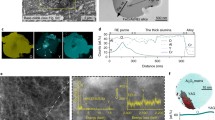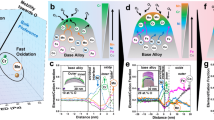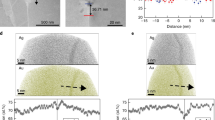Abstract
Despite the advent of numerical modeling approaches and high-performance computing infrastructure, the design and development of corrosion-resistant high temperature alloys (> 500 °C) continue to be largely empirical and typically involve extensive experimentation. This is mainly due to the lack of a single unified physics-based model that can address the impact of multiple competing factors such as time, environment, alloy composition, microstructure, and geometry. The classical Wagner’s criteria have been foundational to estimate the minimum concentrations required of an oxide-forming element to establish and sustain a protective oxide scale. However, the formulation is primarily limited to lower-order alloy systems (binary alloys) and ignores the time dependence of subsurface compositional changes in the alloy. The lack of key data on the temperature and composition dependence of the solubility and transport of oxidants in multicomponent-multiphase alloys further exacerbates the problem. In the present work, a few of these limitations were addressed using a flux-based approach (FLAP) which tracks the spatiotemporal evolution of the fundamental flux balance between oxygen and the oxide-forming elements to enable the prediction of the formation of an external alumina scale in ternary NiCrAl alloys. The modeling results were validated with the literature findings and additional experimental work conducted in the present work.



















Similar content being viewed by others
References
B. A. Pint, JOM 65, 1024 (2013).
D. Pierce, et al., Progress in Materials Science 103, 109 (2019).
P. J. Ennis, W. J. Quadakkers, and H. Schuster, Materials Science and Technology 8, 78 (1992).
R. Pillai, M. Romedenne and S. Lee, Development of an Open-source Alloy selection and Lifetime Assessment Tool for Structural Components in CSP, (United States, Medium: ED, 2022).
R. Pillai, A. Chyrkin, and W. J. Quadakkers, Oxidation of Metals 96, 385 (2021).
I. G. Wright, et al., Lifetime Modelling of High Temperature Corrosion Processes 34, 339 (2001).
D. J. Young and B. A. Pint, Oxidation of Metals 66, 137 (2006).
W. J. Quadakkers and M. J. Bennett, Materials Science and Technology 10, 126 (1994).
E. K. Ohriner and J. E. Morral, Scripta Metallurgica 13, 7 (1979).
A. Chyrkin, et al., Corrosion Science 96, 32 (2015).
R. Pillai, et al., Corrosion Science 127, 27 (2017).
H. E. McCoy, Oak Ridge Nat. Lab. Rev. 3, 35 (1969).
J. R. DiStefano et al., Summary of Modified 9Cr-1Mo Steel Development Program, 1975–1985, (United States. p. Medium: ED; Size: 301 p, 1986).
Y. Yamamoto, et al., Science (New York N.Y.) 316, 433 (2007).
M. P. Brady, et al., JOM 60, 12 (2008).
C. Wagner, Zeitschrift für Elektrochemie, Berichte der Bunsengesellschaft für physikalische Chemie 63, 772 (1959).
J. D. Poplawsky, et al., Scripta Materialia 210, 114411 (2022).
M. Schiek, et al., Oxidation of Metals 84, 661 (2015).
C. S. Giggins and F. S. Pettit, Journal of the Electrochemical Society 118, 1782 (1971).
D. P. Whittle, et al., Philosophical Magazine A 46, 931 (1982).
R. Pillai, et al., Materials at High Temperatures 32, 57 (2015).
R. Pillai, et al., Calphad-Computer Coupling of Phase Diagrams and Thermochemistry 53, 62 (2016).
H. Larsson, H. Strandlund, and M. Hillert, Acta Materialia 54, 945 (2006).
H. Larsson and A. Engstrom, Acta Materialia 54, 2431 (2006).
Thermo-Calc, Thermo-Calc Software TCNi8/Ni-Based Superalloys Satabase Version 8, (Sweden, 2018).
MobNi5, Thermo-Calc Software MobNi5/Ni-Alloys Mobility Database Version 5, (Sweden, 2019).
J. W. Park and C. J. Altstetter, Metallurgical Transactions A 18, 43 (1987).
A. Chyrkin et al., 96, 32 (2015).
R. Pillai, et al., Materials at High Temperatures 35, 78 (2017).
R. Pillai et al., 127, 27 (2017).
R. Pillai et al., Computational Methods to Accelerate Development of Corrosion Resistant Coatings for Industrial Gas Turbines. (Superalloys, 2020).
R. Pillai, S.S. Raiman and B.A. Pint, Journal of Nuclear Materials, 546, 152755 (2021).
R. Pillai, et al., JOM 75, 994 (2023).
C. Wagner, Journal of the Electrochemical Society 99, 369 (1952).
C. S. Giggins and F. S. Pettit, Transactions of the Metallurgical Society of Aime 245, 2495 (1969).
F. H. Stott, et al., Solid State Ionics 12, 365 (1984).
P. Tomaszewicz and G. R. Wallwork, Oxidation of Metals 20, 75 (1983).
A. Chyrkin, et al., Corrosion Science 124, 138 (2017).
A. Chyrkin, et al., Materials at High Temperatures 32, 102 (2015).
J. A. Nesbitt, Journal of the Electrochemical Society 136, 1511 (1989).
F. S. Pettit, Transactions of the Metallurgical Society of Aime 239, 1296 (1967).
R. Klumpes, et al., Werkstoffe Und Korrosion-Materials and Corrosion 47, 619 (1996).
Thermo-Calc, Thermo-Calc Software TCNi11/Ni-Alloys Database Version 11.0, (2021).
Acknowledgements
J. Wade and G. Garner assisted with the experimental work at ORNL. V. Cox, T. Lowe and M. Romedenne are thanked for hel** with metallography and microstructural characterization, respectively. Mackenzie Ridley is thanked for his valuable comments on the paper. The authors are grateful to Michael P. Brady for the technical discussions on the paper. The authors appreciate the continued support of J. A. Haynes as program manager. This manuscript has been authored by UT-Battelle, LLC, under contract DE-AC05-00OR22725 with the US Department of Energy (DOE). The US government retains and the publisher, by accepting the article for publication, acknowledges that the US government retains a nonexclusive, paid-up, irrevocable, worldwide license to publish or reproduce the published form of this manuscript, or allow others to do so, for US government purposes. DOE will provide public access to these results of federally sponsored research in accordance with the DOE Public Access Plan (http://energy.gov/downloads/doe-public-access-plan).
Funding
The authors would like to thank the U.S. Department of Energy, Office of Vehicle Technologies, Powertrain Materials Core Program for funding this work.
Author information
Authors and Affiliations
Contributions
RP was involved in conceptualization, experimental work, data analyses, interpretation, modeling, and original draft writing. CJS contributed to modeling, manuscript review and editing.
Corresponding author
Ethics declarations
Conflict of interest
The authors declare that they have no known competing financial interests or personal relationships that could have appeared to influence the work reported in this paper.
Additional information
Publisher's Note
Springer Nature remains neutral with regard to jurisdictional claims in published maps and institutional affiliations.
Rights and permissions
Springer Nature or its licensor (e.g. a society or other partner) holds exclusive rights to this article under a publishing agreement with the author(s) or other rightsholder(s); author self-archiving of the accepted manuscript version of this article is solely governed by the terms of such publishing agreement and applicable law.
About this article
Cite this article
Pillai, R., Stephens, C.J. Revisiting Wagner’s Criteria to Predict Establishment and Retention of Alumina Scales on Ternary NiCrAl Alloys. High Temperature Corrosion of mater. 100, 683–708 (2023). https://doi.org/10.1007/s11085-023-10202-1
Received:
Revised:
Accepted:
Published:
Issue Date:
DOI: https://doi.org/10.1007/s11085-023-10202-1




